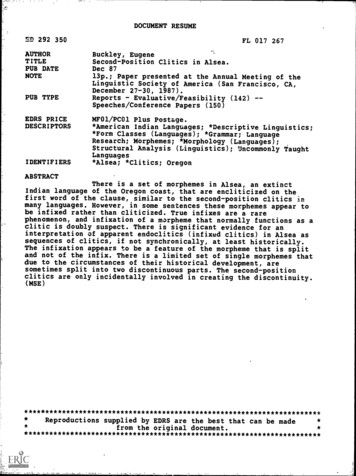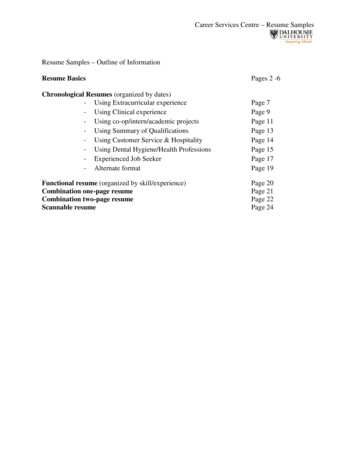
Transcription
DOCUMENT RESUMEED 292 350AUTHORTITLEPUB DATENOTEPUB TYPEEDRS PRICEDESCRIPTORSIDENTIFIERSFL 017 267Buckley, EugeneSecond-Position Clitics in Alsea.Dec 8713p.; Paper presented at the Annual Meeting of theLinguistic Society of America (San Francisco, CA,December 27-30, 1987).Reports - Evaluative/Feasibility (142) -Speeches /Conference Papers (150)MF01/PC01 Plus Postage.*American Indian Languages; *Descriptive Linguistics;*Form Classes (Languages); *Grammar; LanguageResearch; Morphemes; *Morphology (Languages);Structural Analysis (Linguistics); Uncommonly TaughtLanguages*Alsea; *Clitics; OregonABSTRACTThere is a set of morphemes in Alsea, an extinctIndian language of the Oregon coast, that are encliticized on thefirst word of the clause, similar to the second-position clitics inmany languages. However, in some sentences these morphemes appear tobe infixed rather than cliticized. True infixes are a rarephenomenon, and infixation of a morpheme that normally functions as aclitic is doubly suspect. There is significant evidence for aninterpretation of apparent endoclitics (infixed clitics) in Alsea assequences of clitics, if not synchronically, at least historically.The infixation appears to be a feature of the morpheme that is splitand not of the infix. There is a limited set of single morphemes thatdue to the circumstances of their historical development, aresometimes split into two discontinuous parts. The second-positionclitics are only incidentally involved in creating the ons supplied by EDRS are the best that can be madefrom the original ******************************
71,If?"tSECOND POSITION CLITICS IN ALSEA.:Eugene BuckleyUniversity of California BerkeleyPaper presented at the annual meeting of the LSA/AAAL/ADS27-30 December 1987, San Francisco, CAU.S. DEPARTMENT OF EDUCATIONOffice of Educational Research and Improvement"PERMISSION TO REPRODUCE THISMATERIAL HAS BEEN GRANTED BYEDUCATIONAL RESOURCES INFORMATIONThisCENTER (ERIC)This document has been reproduced asreceived from the person or organizationoriginating it.0 Minor changes have been made to improvereproduction QualityPointS 01 view or opinions stated in thisdocirment do not necessarily represent officialTO THE EDUCATIONAL RESOURCESINFORMATION CENTER (ERIC)."OERI position or policy,2
SECOND-POSITION CLITICS IN ALSEA*Eugene BuckleyUniversity of California, BerkeleyThere is a set of morphemes in Alsea (an extinct language of the Oregoncoast) which are encliticized on the first word of the clause: in this respect they areno different from the second-position ethics found in many languages. In somesentences, however, these morphemes appear to be infixed rather than cliticized.True infixes are a fairly rare phenomenon, however, and the infixation of amorpheme that normally functions as a clitic is doubly suspect. There is in factsignificant evidence for an interpretation of apparent endoclitics (i.e. infixedclitics) in Alsea as sequences of clitics, if not synchronically then at leasthistorically. I will begin by establishing that these morphemes are indeed elides,then describe their apparent infixation, and finally discuss the most appropriateanalysis of this behavior.'The morphemesIn Alsea, all subject pronouns, three directionals (uk" 'up, away', auk inside', i 'here), and Ita 'but' are attached to the first word in the clause.2Sentences (1) through (6) illustrate the use of these morphemes.3(1)(2)tem ita milt-1 icea q&n -t -axand but atlast indeed die-STAY CMPL But then he was finally dead.' (64.38)h it e xclapxeltsu.s- atx u xjust EduS ask-PROG-2sgO-CMPL We've simply been asking you a question.' (j72.31)(3)tqai6lt-x 0.want-CMPL lsgS I want it.' (34.9)* I would like to thank Colette Craig for her help on an early version of this paper, as well asthe following people for their comments on an later draft Natasha Beery, Orin Gensler, LeanneHinton, Laura Michaelis, and Lawrence Morgan. This paper was presented at the LSAconference in San Francisco on December 29, 1987.1 All examples cited here are labeled with the page and line number from Frachtenberg (1920),except for those preceded by a l' which come from Frachtenberg (1917). A number of otherAlsea materials exist in manuscript form, but only Frachtenberg's published works offerconnected text.2 These 'second-position clitics' are found in languages all over the world, and were firstdescribed for Indo-European by Wackemagel (1892). The precise definition of 'second position'varies among languages, but for Alsea this position generally occurs after the first word of theclause.3 See the end of the paper for a description of abbreviations used here. The Alsea sentences aregiven in an adaptation of Frachtenberg's original nonphonemic transcription.
2(4)yaha7m iyu ncyclone l sgS I am Cyclone.' (32.15)(5)I.; latiltq-6a anFUT IduS do-TR Q What will we do with it?' (j75.25)(6)tem auktsf.s- alkw i ksand EduS inside jump-DUR canoe-ALL We always jump into the canoe.' (140.34)Examples of what appears to be endoclisisconsidered later.the infixation of a cliticwill beClitics vs. affixesThe notion of a clitic, like any other basic syntactic category, cannot bededuced from other categories; it must instead be defined. Clitics as a class areintermediate between affixes and independent words, sharing characteristics ofboth; to show that a given morpheme is a clitic thus involves demonstrating theshared characteristics. Zwicky and Pullum (1983) list a number of propertieswhich distinguish clitics from affixes; although they were intended for applicationto English data, these properties are of a sufficiently general nature to be usedcross-linguistically. I have condensed them into three properties: selectivity,predictability, and rule ordering.SELECTIVITY refers to restrictions on the types of words to which amorpheme may attach. Affixes generally are restricted to a narrowly definedgroup of roots; for example, the English plural morpheme attaches only to nouns.Clitics, on the other hand, often have low selectivity and can attach to hosts froma wide variety of syntactic classes. This is the case with the Alsea morphemes inexamples (1) through (6), which are found after the first word of the clause,whether that first word is a connective (1), adverb (2), verb (3), noun (4), ortense marker (5). Note that multiple clitics are possible, as in (6). By thiscriterionwhich I consider to be the most important for Alseathesemorphemes are clearly elides.PREDICTABILITY, or regularity, is more typical of clitics than of affixes.Affixes often exhibit idiosyncrasies in semantics and phonology, and are alsomore likely to have arbitrary gaps in their distribution. For example, the Englishsuffix -ed' is not used with many irregular verbs: in 'give' the past tense has nosuffix at all ('gave'), and the past participle has an irregular suffix ('given'). Thelack of such gaps and idiosyncrasies in the Alsea datathe morphemes inquestion always have the same formserves as further support of their status asclitics.44 Frachtenberg (1918:126) points out a minor exception in the order, but not the form, of thepronominal clitics. Very briefly, the order of the clitics marking subject and nonsingular object(identical to the subject pronoun) is reversed for lsgS/3duO to avoid homophony withlduSf3duO.4
3The final criterion, RULE ORDERING, is theory-dependent. According toZwicky and Pullum, clitics are attached to their hosts after syntactic operationshave applied; therefore clitic groups cannot be affected by syntactic rules, andaffixes cannot be attached to a word after it has received a clitic. While theseclaims appear to be valid in their analysis of English, they are of limited use withAlsea since no syntactic rules have as yet been elaborated. Nevertheless, theAlsea data seem to conform to these predictions. For example, multiple clitics arepossible, as shown in (6), but there are no cases of affixes following a clitic. Itshould be noted that Klavans (1985) considers affixed clitics possible, as long asthe affixation takes place before the cliticization. This subject will be discussedmore fully below with regard to endoclisis.Clitics vs. wordsHaving shown that these Alsea morphemes are more like elides than affixes,it is now necessary to look at the other side of the issue, where clitics resemblewords. Zwicky (1985) considers this question and gives an extensive list ofcriteria to distinguish clitics from words, which he freely admits are not entirelyconsistent cross-linguistically. I will summarize the criteria in two categories:phonology and syntax.Clitics, unlike most independent words, form a PHONOLOGICAL unit withthe host, with the result that they can undergo at least some word-internalphonological processes and are usually accentually dependent. This is a difficultcriterion to apply to Alsea, since the language is no longer spoken and there maybe errors in the existing transcriptions. The pronouns consist in many cases ofconsonants only, and epenthetic vowels are often inserted between the host wordand the pronoun. For instance, the first-person singular occurs as -n after avowel in (4), and as -an after a consonant in (3). A similar vowel is present in ist in (5). Such insertion of vowels is not caused by adjacent consonants acrossword boundaries, but is found with affixes (cf. the completive -ex in (1) and -x in(2)), so this epenthesis suggests that these morphemes are not independentwords.The pronouns and directionals are also generally unstressed, as in examples(1) through (6). Sometimes the epenthetic vowel is stressed, though; thishappens most often when it follows the connective tern, as in (8), whereepenthetic [i] is stressed:(7)tem i)tx mqhu. me-tsa.s-au-xaand 3p1S now DUR-win-DUR-CMPL Then they kept winning points.' (24.8)5 The inserted vowel is always short but is usually colored by the adjacent consonants. Forexample, the vowel before the first-person singular -n is realized as [a] when it follows [x] orDO, and as [i] when it follows [m] or OA. Compare sentences (11b) and (16). A high backvowel or diphthong preceding the consonant can cause the epenthetic vowel to be [u], as in (19).These nonphonemic distinctions from Frachtenberg's transcriptions are retained here becausethere is not enough information yet to thoroughly phonemicize the texts.5
4(8)tem 1Xx qa1p6i. wfl-xand 3p1S again come-CMPL Then they arrived again.' (24.12)Most often tern is stressed, as in (7). Clitics in Alsea or at least the epentheticvowels they give rise toseem to be able to take the stress occasionally, but thisstress shift is not consistent. Given Frachtenberg's use of a very narrow phonetictranscription, the stress on such clitics may be very light and probably dependsmore on the stress pattern of the entire sentence than on the word itself noticethat the clitic groups in (7) and (8) each mimic the stress pattern of theimmediately following word. Also, stressed clitics are not unknown; Wanner(1978) describes them in Modern Greek, for example.In the area of SYNTAX, Zwicky says that a simple rule should be adequate todescribe a clitic's distribution; this is true of Alsea, since the morphemes alwaysoccur after the first word of the clause. He notes that such second-position cliticsare, as mentioned earlier, found in many languages, so it should not be surprisingto find such clitics in Alsea as well. Additional syntactic characteristics of cliticsare that they are bound to their host (they do not occur in isolation), are strictlyordered with respect to the host, and are not independently subject to syntacticrules which take words as input. All of these statements apply to the Alseamorphemes.Besides these phonological and syntactic criteria, Zwicky also suggests aMETACONSIDERATION: when in doubt, call something a word rather than anaffix, and an affix rather than a clitic. This suggestion stems from an assumptionthat independent words are the least-marked morphemes, and clitics the mostmarked of the three types. Judging from the relative frequency of each type ofmorpheme cross-linguistically, this seems to be a reasonable ordering. Given thecriteria outlined in the previous few pages, though, it should be clear that theAlsea morphemes are neither words nor affixes, but rather true clitics.6InfixationBefore continuing with the discussion of Alsea clitics, I will describe what Iconsider to be 'prototypical' infixation, so that I can contrast it with what is foundin Alsea. Tagalog will serve as an illustration.In prototypical infixation, a given affix breaks a monomorphemic root intotwo pieces. For example, the Tagalog infixes [-um-] 'actor focus' and [-in-] object focus' (Schachter and Otanes 1972) occur before the first vowel of thestem they modify, thereby separating the initial consonant from the rest of thestem:6I am settling here for the somewhat general term 'elide', though it is possible todistinguish various types. The Alsea pronominal elides are 'special clitics' in the terminologyof Zwicky (1977) and Zwicky and Pullum (1983), since their syntax differs from that of thecorresponding independent words (i.e. the emphatic pronouns); since no full forms exist for thedirectionals or ita, these are 'bound words' in Zwicky (1977) but 'special elides' as well inZwicky and Pullum (1983), where the two categories are merged.
5(9)['su:lat][su'mu:lat][si'nu:lat]'a writing''one who wrote''that which was written' (Bloomfield 1933:218)The stem-internal position of the infix is determined not by the stem, but rather bythe infix itself: there must be a lexical feature of the particular affix which statesthat it occurs inside the stem. This means that a new word in the language is alsosusceptible to being broken by an infix, as the verb [sorpresa] borrowed fromSpanish demonstrates:(10)S-in-orpresa si Maria ni Juan. Maria was surprised by Juan.' (Sweetser 1980:17)The essential point is that prototypical infixation is a feature of the affix, not thestem to which it is attached. This fact will be contrasted with the situation inAlsea below.EndoclisisThere is a limited set of words in Alsea in which the clitics appear to beinfixed, breaking the apparently monomorphemic word into two parts. Examplesare given here in pairs, showing the words first with and then without the putativeendoclitics:(11) negative 'Xiya? (also the word for 'no')a.'X iya? q6-ulseaitqa161d-exNEG ERG-someone want-CMPL No one wanted to.' (j72.20)b.(12)a.IX /an/iya? tqai6lt-exNEG-lsgS-* like-CMPL I don't like it.' (48.18)habitual !sets!sets tiu.thun-6-1n-xkus tsuwixHAB make-INCH-PAS-CMPL DET rope They used to make rope.' (166.4)b.tai? OnustIs /1112/tsgetsHAB-away-* only always stand-INCH behind She would always stand behind (them).' (24.17)(13) resultative Isisa.IsisIs imtkal }ts -i -mRES there burn-INCH-INTR .a fire would start there.' (212.18)7
6b.!;/al/spupanhau-tx--6t-mRES-1p1S-* play.shinny-PROG-INCH-INTR .then we'll play shinny.' (24.3)(14) irrealis complementizor sisa.sistqaiald-iCOMP want-TR If he wanted to.' (154.1)b.si/u/stqai al d- i.COMP-2p1S-* want-TR If you want to.' (24.3)(15) concessive lasa.la's011ot-it s lehwiCON hard -ADJ DET ground Although the ground is hard.' (158.31)b.la./n/sni*-ilo ay-6i.-mCON-lsgS-* far-ALL go-INCH-INTR No matter how far I go.' (176.27)All of these words are found frequently as undivided units, as in the examplesmarked (a), which might lead to the conclusion that they are single morphemes.This would, however, require that the (b) sentences of each pair be analyzed ascases of endoclisis.Klavans (1985), building on work in Klavans (1979) and arguing againstZwicky (1977), claims that the infixation of a clitic is impossible. Her mainexample involves a sequence of the form X-Y-Z where X is a verb, Y is a clitic,and Z is a suffix. Instead of saying that the cliticized form X-Y is inflected with Z(which would violate the rule-ordering criterion given above), she says that elidescan be inflected just like other syntactic classes. The suffix Z is added to the cliticY to form the group Y-Z, which is then cliticized on the host X.In Alsea the situation is somewhat different, since the would-be element Z isin none of the examples recognizable as a suffix. In fact, the selectivity criterionargues strongly against an analysis of Z as an affix, since it can attach to clitics ofthree quite different types: pronouns, directionals, and Ita. These final elements,if not part of a single root X-Z, must be clitics as well. Upon closer analysisthere is actually a fair amount of evidence for relating the different halves of eachof these 'words' to other morphemes, suggesting that they might have someindependent existence. First, the evidence for analyzing the words intocomponent morphemes.DissectabilityOne of the clearest examples of words that can be 'dissected' involves thehabitual K ats (12) and resultative Is is (13). The first element of each,corresponding to X, is phonetically identical to the future Is- (which is itself8
7phonologically a proclitic, but syntactically treated as a word). This Is- occurs inthe same initial position and is thus also followed by the second-position elides:(16)Is ja6LA pku.ts-1.1.0FUT lsgS near gather-TR'I'il gather them nearby.' (194.3)(17)Is 31101.1.1s an qauwis Xot -6i.-mFUT up who Q firstclimb-INCH-INTR Who will climb up first?' (60.7)This similarity suggests that it might be possible to interpret kats and Is is ascliticized versions of Is-, where the ethics -ts and -s change the meaning of thewhole. It would simply be necessary to state that the pronouns and directionalsoccur before the 'inherent' clitics of each cluster. The same -s clitic in is (withepenthetic vowel) may also be the final element of sis and las, since they, likeIsis, take the irrealis mood.Kets,however, always takes the realis, so somehow -would have to 'override' the irrealis mood normally governed by Is-. Thisclaim is harder to accept, especially since -ts is not found except in thiscombination? This sort of inconsistency will be seen again several times in thetsrest of this discussion.Although the second element of sis may be the same as that of kis, its firstelement is totally obscure.8 This is not true of la's, however, since la is found incombination with !sots, where the meaning is approximately that of la's by itself(compare (15) above) with the addition of a habitual idea:(18)kats1-1.11.d-au-sx,xamil16.1satsHAB DUR-talk-DUR-REFL CON.HAB alone'He would talk to himself, even though he was alone' (180.7)The combination 16.1sets acts as a single word, and a clitic is inserted in the sameplace as when !sots occurs alone.(19)16.k/golutsay-6iof sk-iksCON.HAB-3duS-* go-INCH far-ALL'No matter how far they went.' (160.8)Here the meaning of the parts is fairly clear, but nevertheless lals- patterns asthough it were a single syntactic unit.There is also some justification for thinking that the negative 'X iya? consistsof two elements. The supposed clitic -iya? is not found elsewhere, but iX- isfound as a verb meaning 'refuse, say no to (someone)':(20) tem Alta !ka?y- 6i.- nxand but refuse-ITER-INCH-him But he steadfastly refused his request.'7 The element -ts is occasionally found withoutbut it still carries a habitual meaning.Note that precisely because -ts is found nowhere else, this reduction creates no ambiguity.8 Both sis and 1; is are infrequently found as just -s; for example, st-is instead of s-ist-is(COMP/IduSt*).9
-48(21)tern a-asx-áixaand refuse-REFL-INCH-CMPL He refused to do it.'Note that in (20) the initial vowel [i] reduces, corresponding exactly to thereduced vowel in IXiya?. The similarity in meaning and form is very strongevidence that, at least etymologically, the negative IXiya? consists of IX- plussome other element.The Alsea data differ significantly from the examples given by Klavansbecause the final elements of the words are in all cases of uncizar meaning andapparently quite unproductive. For example, k- may have Functioned as anirrealis complementizer when it was originally combined with -s and -ts, but inIsis and sits its reflex serves only as half of the resultative and habitualmorphemes. Even if, say, the -s of Isis were defined as 'resultative', it wouldthen be necessary to call the -s in sis and la's a different clitic of uncertainmeaning, which defeats the purpose. In fact, the position of the second-positionelides is the only clear syntactic evidence that each of these words may once haveconsisted of two distinct morphemes .9 A synchronic interpretation of thesewords as single but sometimes discontinuous morphemeswhere neither partcan be said to carry any particular portion of the total meaningseems 'lest.The clitics themselves are not prototypical infixes as exemplified by Tagalog,since they behave as enclitics except in special circumstances: it is not the case thatthe elides are inherently infixal, but rather that they show up as infixes whenadded to a few particular host words.Historical ExplanationThe present state of affairs in Alsea can be explained by mating reference tothe process of grammaticalizationthe historical development of a freemorpheme into somcthing which is more bound and obligatory, accompanied bysemantic and phonological attrition (see Lehmann (1985) for a more completeexplanation). Taking the example of k-, Isis, and eats, we can attempt to retracethe steps that led these morphemes to their present form.Suppose that at some point in the history of Alsea there was a clause-initialparticle, phonetically something like ts- (though at this stage it may have had aphonemic vowel). Perhaps it marked the irrealis mood, perhaps something else.Subject agreement was shown by an enclitic on this particle, as it is today.Certain variations in meaning were possible by adding other particles to thesentencesay sa to indicate a result and tas to indicate habitual action. Likeother modal elements, they gravitated to the beginning of the clause. With timethey began to lose their stress and cliticized on the word to their left sometimesa subject pronoun, but often just the particle k- since there was a zero subject in9 The abbreviated forms noted in the previous two footnotes might also be considered evidenceof historical (or even synchronic) separateness. On the other hand, the realis complementizcrm is, which unlike the irrealis sis takes the normal enclitic pronouns and acts like a singlemorpheme, occasionally appears to be shortened to s as well. Also, the connective tern anddeterminer kus are sometimes found together as m uk us, though I would hesitate to say that ternconsists of two partsespecially in the synchronic grammar.
9the third-person singular. Finally they lost their independent identity and becamesimply a part of a single morpheme which included the original Is- particleexcept that sometimes the morpheme was split in half by a subject pronoun whichhad been there all along. The following diagram illustrates the progression, usingthe first-person singular -n as an example:irrealis1Is n k in2k nk n345 k in Is in1s n k ink n k inresultativehabitualIs n as Is in ask n as Is in ask n s Is in sIsis n Is/in/sIs n tas Is in task n tas Is in task n ts Is in tsIsats n Is/in/tsEach numbered row represents a historica! stage of the language; the arrows referto a synchronic correspondence between the underlying morphemes and theirphonetic realization. At stage 1 there is only the partic.ie Is- followed by thesubject pronoun. Stage 2 includes the particles as independent words whichmodify the meaning of Is-. By stage 3 these independent particles have lost theirstress and become cliticized on the first word in the clause. This loss of stressleads to the loss of the vowel of the last clitic at stage 4. Finally, at stage 5 thesecond elements of the resultative and habitual have ceased to be meaningful bythemselves: they each combine with Is- to express the resultative or habitualmeaning. When a subject pronoun (or directional) is also present, it retains itsoriginal position immediately after Is-, separating the two parts of the resultativeand habitual morphemes in the process.This scenario is intended to suggest the way in which the endoclisis' mayhave arisen. It is difficult to find independent evidence for this diachronicdevelopment, since the relationship of Alsea to other languages has yet to beclearly proven. Comparison with forms in a language demonstrably related toAlsea could yield more precise hypotheses.ConclusionIn one sense, what we observe in Alsea is endoclisis: a clitic that breaksapart another morpheme. Here, however, the infixation is a feature of themorpheme that is split, and not of the infix. In reality we have a limited set ofsingle morphemes which, due to the circumstances of their historicaldevelopment, are sometimes split into two discontinuous parts. The secondposition elides are only incidentally involved in creating the discontinuity.11
APPENDIXAlsea Subject Clitics1st personsingulardual n xan (excl) st (incl) pst2nd person3rd person 0 auxMorphemes which can be split by a second-position clitic1Xiya?(IX/tya?)sis(s/3)Isis(j /s)tatlaslaxslaatsla tis(tits)(Is/Sit)(1 /s)!lax /s)(la/ts)(la/s)negativeirrealis veconcessiveconcessive habitualconcessive resultativeAbbreviationsIn the glosses in this paper, translations of lexical meaning are given inlower case, and grammatical functions are given in upper case. The followingabbreviations have been used: ADJ adjectival, ALL allative, CON cencessive,COMP complementizer, CMPL completive, DUR durative, ERG ergative, FUTfuture, HAB habitual, INCH inchoative, ITER iterative, INTR imansitive(irrealis), NEG negative, PROG progressive, Q interrogative, REFL reflexive,RES resultative, STAT stative, TR transitive. For pronouns: 1, 2, 3 first,second, third person; I, E inclusive, exclusive (first person); sg, du, pl singular, dual, plural; S, 0, 10, P subject, object, indirect object, possessive.An asterisk (*) marks the second half of a discontinuous morpheme that has beendivided by a clitic; the first half is the initial element of the morpheme cluster.Affixes are set off by a hyphen (-), clitics by an equals sign (.), and 'endoclitics'by a slash (/).The transcription system used here is the Arnericanist alphabet, with theaddition of the palatal stop [Is] and Frachtenberg's 'resonance and epentheticvowels' written as small raised letters.2
11ReferencesBloomfield, Leonard. 1933. Language. New York: Henry Holt and Company.Frachtenberg, Leo J. 1917. Myths of the Alsea Indians of NorthwesternOregon. International Journal of American Linguistics 1.64-75. 1918. Yakonan (Alsea) Grammar. Unpublished typescript in the FranzBoas Collection of the American Philosophical Society Library,Philadelphia.1920. Alsea Texts and Myths. Washington: Bureau of AmericanEthnology, Bulletin 67.Klavans, Judith L. 1979. On clitics as words. The Elements: A Parasession onLinguistic Units and Levels. Chicago Linguistic Society.--. Language1985. The Independence of Syntax and Phonology in Cliticization.61.95-120.Lehmann, Christian. 1985. Grammaticalization: synchronic variation anddiachronic change. Lingua e stile 20.303-18.Macaulay, Monica. 1984. Special Field Exam. Department of Linguistics,University of California, Berkeley.1987. Morphology and Cliticization in Chalcatongo Mixtec. Ph.D.dissertation. Department of Linguistics, University of California, Berkeley.Schachter, Paul, and Fe T. Otanes. 1972. Tagalog Reference Grammar.Berkeley: University of California Press.Sweetser, Eve. 1980. Tagalog our;; (Ithood Revisited. M.A. thesis.Department of Linguistics, University of California, Berkeley.Wackernagel, Jacob. 1892. Uber ein Gesetz der indogermanischen Wortstellung.Indogermanische Forschungen 1.333-436.Wanner, Dieter. 1978. Modern Greek Clitics: Placement, Order, and Function.Berkeley Linguistics Society 4.268-282.Zwicky, Arnold M. 1977. On clitics. Bloomington: Indiana UniversityLinguistics Club.Clitics and Particles. Language 61.283-305.Zwicky, Arnold M., and Geoffrey K. Pullum. 1983. Cliticization vs. Inflection:English n't. Language 59.502-13. 1985.
Eugene Buckley University of California Berkeley. Paper presented at the annual meeting of the LSA/AAAL/ADS 27-30 December 1987, San Francisco, CA "PERMISSION TO REPRODUCE THIS MATERIAL HAS BEEN GRANTED BY. TO THE EDUCATIONAL RESOURCES INFORMATION CENTER (ERIC)." 2. U.S. DEPARTMENT OF EDUCATION Office of Educational Research and Improvement











